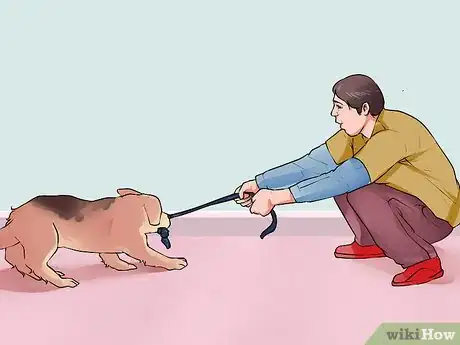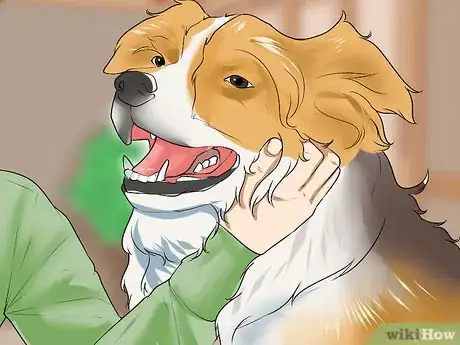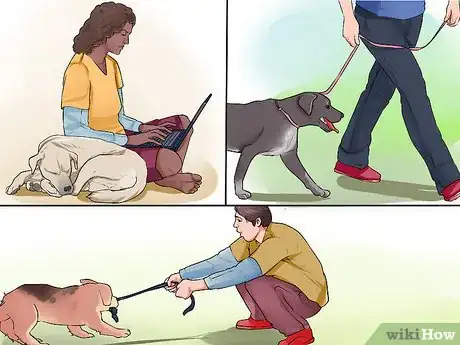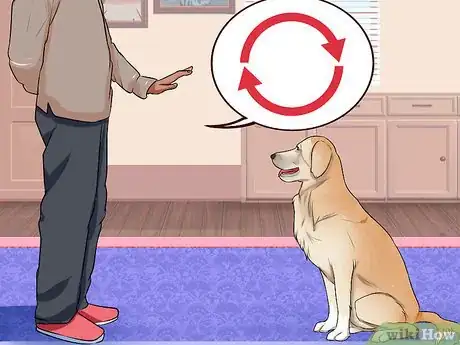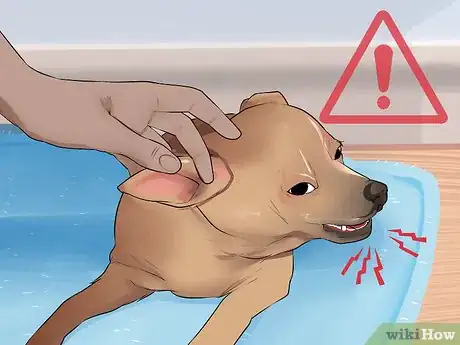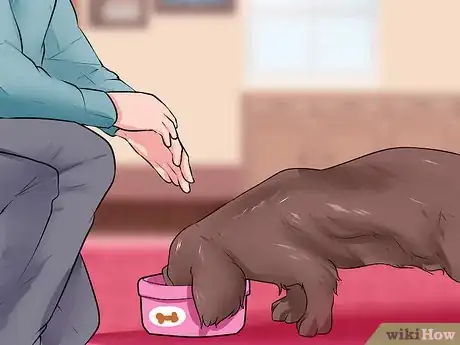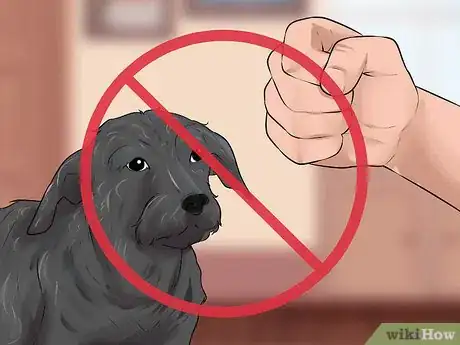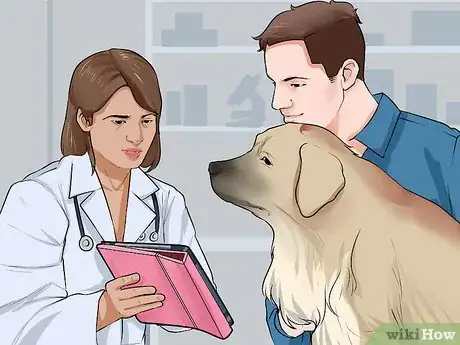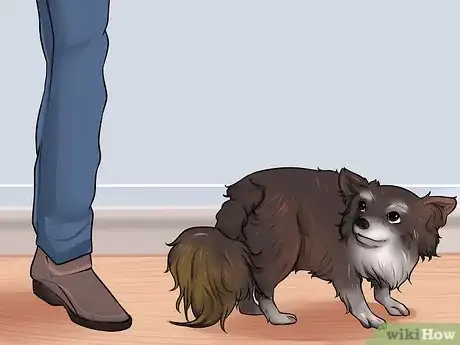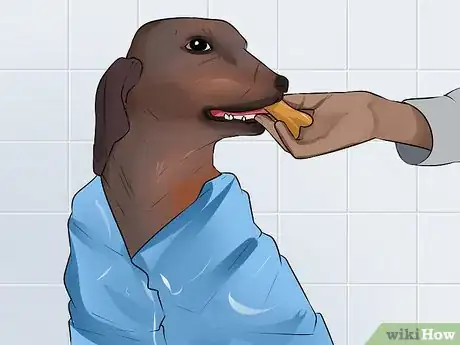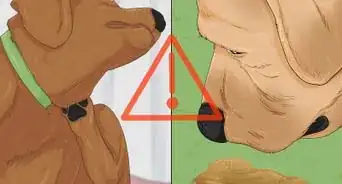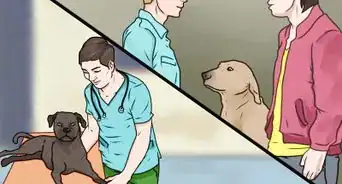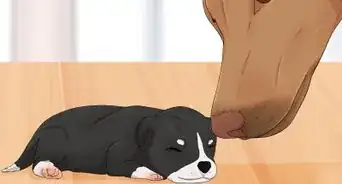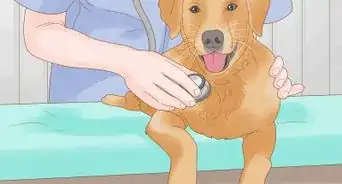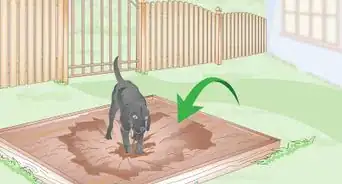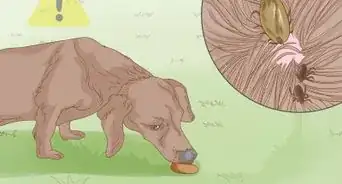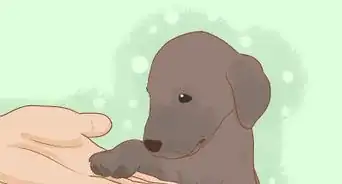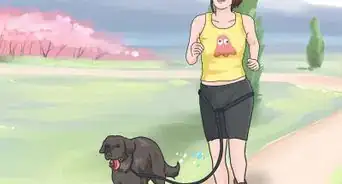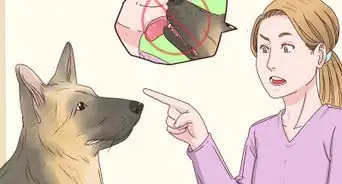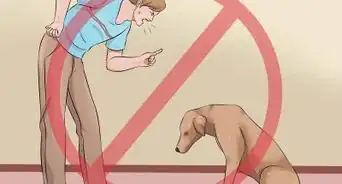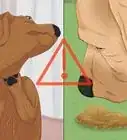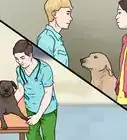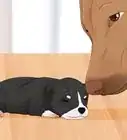This article was co-authored by Ryan Corrigan, LVT, VTS-EVN. Ryan Corrigan is a Licensed Veterinary Technician in California. She received her Bachelor of Science in Veterinary Technology from Purdue University in 2010. She is also a Member of the Academy of Equine Veterinary Nursing Technicians since 2011.
This article has been viewed 25,588 times.
Aloof dogs can be difficult to bond with. No matter what you do, you may not be able to form a connection. To bond with aloof dogs, you should try spending time with your dog, be consistent with your expectations, and respect your dog’s space and dislikes.
Steps
Spending Time With Your Dog
-
1Play with your dog. A good way to build a bond with an aloof dog is to play with them. Dogs love to run, chase, and chew. Incorporate these things into your interactions with your dog. You may have to coax them into playing because they’re aloof, but keep working at it until the dog comes around.[1]
- Try going out into the backyard and running around with your dog. You can try playing fetch with them by throwing toys they enjoy.
- Just because your dog won’t fetch doesn’t mean they don’t like to play. Try different games or toys like tug-of-war, frisbees, and balls that light up or make noise.
- Get Kong toys and hide cheese or treats inside them so they can work to get them out.
-
2Walk your dog. You can bond with your dog by taking them for walks every day. Keep the leash loose so they can explore while they are with you. This will stimulate them and provide them with entertainment, and they will connect this positive experience with you. By controlling the leash and leading the dog, you are helping show the dog you protect and care for them.[2]
- Talk to your dog while you walk them. Pet them occasionally and interact on the walk.
- Let your dog explore instead of forcing them to do what you want to do the entire time. If they want to stop and sniff something, let them. However, remember you are the leader and are protecting them. Make sure they don’t end up in something dangerous.
- You can make the walks more interesting by exploring different parks, neighborhoods, dog parks, beaches, or trails that are available near where you live. Going on new adventures together will help create a bond between you and your dog.
Advertisement -
3Spend time with your dog. You are not going to bond with your dog if you don’t spend time with them. You can do this by playing and exercising with your dog, taking them to obedience classes, training them, and being in the same room with them.[3]
- Encourage your dog to lay or sleep in the room you are in. When you are in the living room, fix up a bed for them to lay on or place blankets near the couch or chair. Fix them a bed in the bedroom so they can sleep near you.
-
4Give your pet physical affection. Touching your dog can help you build a bond. Touch involves many different things. You can pet your dog, paying attention to places they like to be petted and places they don’t.[4]
- Try grooming your dog. This touch can make your dog feel safe and start to build a bond between you.
- Like humans, dogs need lots of physical contact so spend time petting, scratching, and rubbing your dog. Even just letting your dog lay with you on the couch can help your dog bond with you.
Making a Connection
-
1Be consistent with your dog. Bonding with your dog is easier when you are consistent. Dogs like routine and clear expectations. When you use the same commands, expect the same behavior, and reinforce rules the same way, your dog will respect you and feel comfortable because they know what to expect.[5]
- For example, if you don’t want your dog on the furniture, don’t let them on the furniture. Don’t allow them on the couch or bed for a “special treat,” and then punish them when they get on the furniture the next time.
-
2Remain calm. You cannot gain a dog’s trust and bond with them if you are not calm. Yelling, getting angry, or lashing out is one guaranteed way of making an aloof dog even more aloof. Instead, respond to frustrations with a calm voice and level manner.[6]
- If you are frustrated with your aloof dog, take a moment to breathe. Inhale through your nose and then out for a count of 4. This will help you control your temper.
- If you want to get angry, yell, or hit the dog, walk out of the room. These behaviors will do more harm than good.
-
3Use consistent commands. Dogs are good at learning physical commands, and eventually learning vocal commands, but they get confused when you change it up. Using consistent commands helps your dog know what you expect, act accordingly, and receive praise from you, which helps strengthen the bond.[7]
- They can’t understand you when you talk to them. They understand consistent gestures and one-word commands they’ve been taught.
Establishing Trust
-
1Respect the dog’s space. Aloof dogs may take time to warm up to you. This may be due to their upbringing, the fact that they were in a shelter, or their overall temperament. Don’t shower too much attention on the dog. Let the dog know you are there, show them affection, but give them space. Let them come to you. Don’t always go to them.[8]
- While you are bonding with your aloof dog, it will take time for them to warm to you. As you work on the bond, give them time to miss you and make the decision for themselves to come to you and want to be near you.
- Work with the dog and be patient while you both learn each other’s likes, dislikes and space requirements.
-
2Pay attention to your dog’s dislikes. Dogs, like people, have preferences. A way to bond with your dog is to figure out what they like and don’t so you can avoid forcing them to do or eat things they don’t like.[9]
- For example, your dog may hate having their ears touched, wearing clothes, or being around loud noises. Knowing what to not do around your dog can help demonstrate to them that you care and strengthen their sense that you will protect them.
-
3Make the dog rely on you for food. You may want to adopt a routine where you feed your dog instead of leaving food out all day. This can help your dog associate you with food, which will help you be an important provider for them.[10]
- Pick 2 to 3 times each day you can consistently give your dog food. Feed your dog at the same time every day.
-
4Avoid using violent actions. To build trust with your aloof dog, you should never use violence. This includes physical violence, like hitting or kicking, as well as harsh words. Yelling or screaming will not get an aloof dog to bond with you.[11]
- Usually, a raised voice with a firm “no” is enough to teach a dog not to repeat a behavior.
- Don't punish your dog for not wanting to do things they don't want to do, like go for walks, be groomed, or take a bath. Instead, be patient, calm, and use positive reinforcement.
- Use short time-outs in the dog’s crate as a consequence for bad behavior, if necessary. ===Dealing with Resistance and Setbacks===
-
5Take your dog to the vet. If your dog doesn't warm up to you or doesn't get excited around you, you may consider taking them to the vet. There may be an underlying medical problem that is causing them to feel bad or be lethargic.[12]
- Some medical conditions can cause fatigue, depression, or overall lack of exuberance.
-
6Consider whether or not you dog is frightened of you. Another reason your dog may be aloof is because they have had a bad experience with you. Figure out if you have punished your dog when you have come home or when the dog has approached you.[13]
- If you believe this is a reason for your dog to be aloof, you should work on providing your dog with more positive associations with you. For example, after you come home, give your dog love, take them for a walk, or play with them. When the dog comes when you call them, give them a treat.
-
7Emphasize positive experiences. If your dog remains aloof, try to make every experience positive. This includes things your dog may hate, like a bath. When you need to do something your dog may not like, try to use positive reinforcement to make it more pleasant for your dog and form a bond with them.[14]
- For example, you may get bath toys for or give treats to your dog to help make it a better experience. This may have to be done gradually as you help train your dog to associate positive ideas with the unwelcome activity.
References
- ↑ http://moderndogmagazine.com/articles/how-improve-your-bond-your-dog/69308
- ↑ https://www.cesarsway.com/dog-psychology/pack-leader/how-to-get-a-dog-to-trust-you
- ↑ http://thebark.com/content/9-ways-improve-your-relationship-your-dog
- ↑ http://thebark.com/content/9-ways-improve-your-relationship-your-dog
- ↑ http://thebark.com/content/9-ways-improve-your-relationship-your-dog
- ↑ http://shibashake.com/dog/build-a-strong-bond-with-your-dog
- ↑ http://moderndogmagazine.com/articles/how-improve-your-bond-your-dog/69308
- ↑ https://www.cesarsway.com/dog-psychology/pack-leader/how-to-get-a-dog-to-trust-you
- ↑ http://thebark.com/content/9-ways-improve-your-relationship-your-dog
- ↑ http://moderndogmagazine.com/articles/how-improve-your-bond-your-dog/69308
- ↑ http://iheartdogs.com/11-ways-to-strengthen-your-bond-with-your-dog/2/
- ↑ http://moderndogmagazine.com/articles/unaffectionate-dog/368
- ↑ http://moderndogmagazine.com/articles/unaffectionate-dog/368
- ↑ http://iheartdogs.com/11-ways-to-strengthen-your-bond-with-your-dog/2/
About This Article
To bond with an aloof dog, try to respect its space and give it time to warm up to you. You should still show it affection and do fun things with it, but avoid forcing it to spend a lot of time with you. Eventually, your dog will learn to trust you, but it might take some time. In the meantime, try taking your dog on daily walks so the two of you can explore together. You can also give it treats and pet it to start gaining its trust. However, if your dog doesn't like being pet, back off for a bit so you don't upset it. Additionally, try out a few different games to find which ones your dog likes, like fetch, tug of war, or frisbee, so the two of you can play together and bond. For advice from our Veterinary co-author, like how to train an aloof dog, keep reading!
